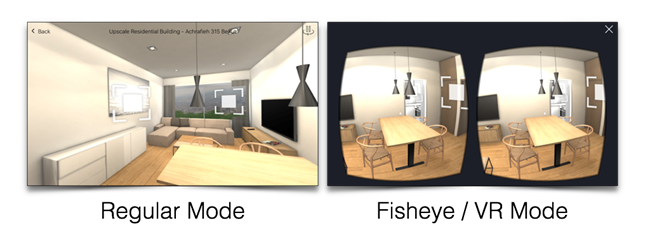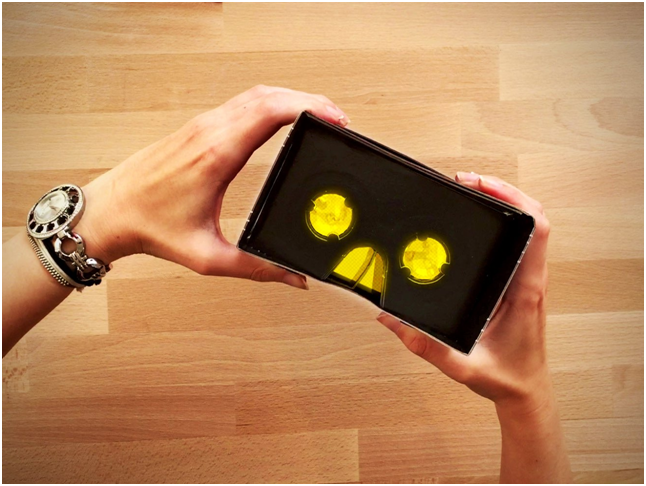This post gives a short summary of the landscape of VR devices and tools available today, starting with mobile devices. I will also outline some pitfalls. A follow-up post will deal with non-mobile devices and a third part will talk about the tools used to create VR content and optimizing your content for maximum reach.
Mobile Devices & Viewers
The concept is simple: you use your existing smartphone and put it into a VR viewer. The smartphone then acts as a display and processing unit for the VR content at the same time. The VR content can be 360 media (images or video) or real-time 3D scenes rendered by a game engine—both types of content usually feature interactions like hotspots or animations which can be triggered while in VR mode to make the content more engaging. The content will arrive on your smartphone as part of an app or via the mobile web browser on your smartphone (more on that later). Before you can put the smartphone into the VR viewer, you need to enable Cardboard mode / VR mode / distortion mode / fisheye mode on it. This will display the content as two images on the screen, one for each eye.

Regular Mode vs. Fisheye/VR Mode for a real-time 3D scene
Popular mobile VR viewers are Google Cardboard, which comes in many, many versions, shapes, sizes and finishes. And there’s Samsung’s GearVR, which comes in three distinct device generations.
Google Cardboard is a standard design, which is publicly available and can be manufactured by anybody. Thus Cardboards are available from many manufactures, either made from actual cardboard or out of plastic. There’s different versions ranging from simple ones to more advanced ones which include headphones and/or the ominous “button” (more on that later). Chances are that if you own a smartphone which has at least a 4-inch screen there will be a suitable cardboard device available for you to purchase and use. The ones made from cardboard are often used as giveaways at events and trade shows. The user experience is rather complicated: you have to install a Google Cardboard-enabled app and scan the Cardboard QR code printed on the device itself with your phone. More often than not, this graphical code is missing on the device. As there are different versions of the Google Cardboard Standard being manufactured, you need to tell the Cardboard-enabled app which version you are using. Otherwise,distortedcontent is displayed whichdoes not match the lenses in your Cardboard device.That makes the experience blurry, distorted, or un-viewable altogether. In a casual survey we do with our customers, we find that while 7 out of 10 have a Cardboard device available only 1 out of 10 has used a Cardboard Device successfully with good results due to these limitations.

Google Cardboard with Smartphone inserted
Samsung GearVRuses the same concept but comes as a sturdy plastic viewer, which has some additional ports built in and actually connects to the inserted Android device via the micro USB connector at the bottom of the device.
Through this,GearVR can address one issue Google Cardboard cannot address: user input. As the smartphones are inserted into the VR viewer in both cases it is not possible to touch the screen.Thus the only available form of interaction ismotiongestures (i.e. shaking the device) or focusing on elements in the virtual environment, which are activated after a certain amount of time (this is called gaze-based interaction). While motion-gesture interaction is limited to only a few suitable use cases, gaze-based interaction has become the de-facto standard in VR,even with apps targeted to be used with the GearVR, which offers a D-PAD and additional button on the right side. Because of these dedicated user input controls, we at Vuframe call GearVR a “more dedicated” VR device than Google Cardboard, which we call a “casual VR device”. Google Cardboard only features a very unsuccessful attempt to emulate this with “the button”: for the Cardboard devices which include this feature, the user can press (actually it is more like a mechanical switch) a button on the side of Cardboard viewer, which then triggers a magnet. The magnet is “sensed” by the smartphone’s compass sensor and interpreted as a click. It’s as crazy as it sounds and it does not really work even half the time.
An honorable mention in the category of mobile viewers and user input goes to Google’s new (or other) VR platform. It is called Daydream and comes with its dedicated, fabric-foam viewing device which includes a remote, motion-enabled remote for user input. This device allows pointing in VR space and translates a second degree of motion, which can simulate the user’s hand. It’s a much better take on VRinput and it is definitely the interaction pattern we would want to see established as the new standard. Google Daydream is not yet showing any clear traction based on reliable sales figures.
In summary, you will reach most people by sticking with a device-neutral, gaze-based way for the user to interact with your content.
What about audience size?
Google Cardboard is currently the device with the widest spread, with approximately 85 million devices in circulation at the end of 2016 (see [1] and [2]). Mind you, many of those devices have probably been branded giveaways; there are not really 85 million active Cardboard users out there; many are just lying in a corner somewhere gathering dust.
GearVR’s reliable figures put the number of sold units in 2016 at 5 million, with a liberal guess of 6.5 million at the time of writing this post. As mentioned above: for Google Daydream, it’s still very early days. As far as mobile viewers are concerned, you are covered by sticking with Cardboard and GearVR, both will give you an approximate audience which will hit 100 million circulated devices in size sooner rather than later in the course of this year.
Read on about Dedicated VR Devices & Workstation-based VR in the next post.
Sources:
[1] http://venturebeat.com/2017/02/04/superdata-vrs-breakout-2016-saw-6-3-million-headsets-shipped/
About the Author
Andreas Zeitler is Founder and CEO at Vuframe. He’s been working with augmented andvirtual Reality on a daily basis for the past 8 years. Vuframe’s mission is to democratize AR & VR by removing the tech barrier for everyone.










![How to create sales analysis app in Qlik Sense using DAR method [Tutorial] Financial and Technical Data Analysis Graph Showing Search Findings](https://hub.packtpub.com/wp-content/uploads/2018/08/iStock-877278574-218x150.jpg)